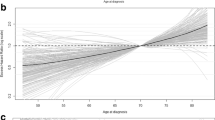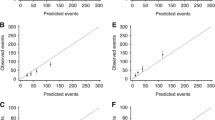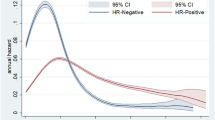Abstract
Use of parametric statistical models can be a solution to reduce the follow-up period time required to estimate long-term survival. Mould and Boag were the first to use the lognormal model. Competing risks methodology seems more suitable when a particular event type is of interest than classical survival analysis. The objective was to evaluate the ability of the Jeong and Fine model to predict long-term cumulative incidence. Survival data recorded by Institut Curie (Paris) from 4761 breast cancer patients treated and followed between 1981 and 2013 were used. Long-term cumulative incidence rates predicted by the model using short-term follow-up data were compared to non-parametric estimation using complete follow-up data. 20- or 25-year cumulative incidence rates for loco-regional recurrence and distant metastasis predicted by the model using a maximum of 10 years of follow-up data had a maximum difference of around 6 % compared to non-parametric estimation. Prediction rates were underestimated for the third and composite event (contralateral or second cancer or death). Predictive ability of Jeong and Fine model on breast cancer data was generally good considering the short follow-up period time used for the estimation especially when a proportion of patient did not experience loco-regional recurrence or distant metastasis.


Similar content being viewed by others
References
Kaplan EL, Meier P (1958) Nonparametric estimation from incomplete observations. J Am Stat Assoc 53(282):457–481
Pocock SJ, Clayton TC, Altman DG (2002) Survival plots of time-to-event outcomes in clinical trials: good practice and pitfalls. Lancet 359(9318):1686–1689
Boag JW (1949) Maximum likelihood estimates of the proportion of patients cured by cancer therapy. J R Stat Soc Ser B Methodol 11(1):15–53
Mould RF, Boag JW (1975) A test of several parametric statistical models for estimating success rate in the treatment of carcinoma cervix uteri. Br J Cancer 32(5):529–550
Mould RF, Lederman M, Tai P, Wong JKM (2002) Methodology to predict long-term cancer survival from short-term data using Tobacco Cancer Risk and Absolute Cancer Cure models. Phys Med Biol 47(22):3893
Tai P, Yu E, Shiels R, Pacella J, Jones K, Sadikov E, Mahmood S (2005) Short-and long-term cause-specific survival of patients with inflammatory breast cancer. BMC Cancer 5(1):137
Kalbfleisch JD, Prentice RL (2011) The statistical analysis of failure time data, vol 360. Wiley, Hoboken
Jeong J-H, Fine J (2006) Direct parametric inference for the cumulative incidence function. J R Stat Soc Ser C Appl Stat 55(2):187–200
Gooley TA, Leisenring W, Crowley J, Storer BE et al (1999) Estimation of failure probabilities in the presence of competing risks: new representations of old estimators. Stat Med 18(6):695–706
Komoike Y, Akiyama F, Iino Y, Ikeda T, Akashi-Tanaka S, Ohsumi S, Kusama M, Sano M, Shin E, Suemasu K, Sonoo H, Taguchi T, Nishi T, Nishimura R, Haga S, Mise K, Kinoshita T, Murakami S, Yoshimoto M, Tsukuma H, Inaji H (2006) Ipsilateral breast tumor recurrence (IBTR) after breast-conserving treatment for early breast cancer. Cancer 106(1):35–41
Choudhury JB (2002) Non-parametric confidence interval estimation for competing risks analysis: application to contraceptive data. Stat Med 21(8):1129–1144
Saphner T, Tormey DC, Gray R (1996) Annual hazard rates of recurrence for breast cancer after primary therapy. J Clin Oncol 14(10):2738–2746
Somda SM, Leconte E, Boher J-M, Asselain B, Kramar A, Filleron T (2014) Optimal scheduling of post-therapeutic follow-up of patients treated for cancer for early detection of relapses. Stat Methods Med Res 0962280214524178. http://www.ncbi.nlm.nih.gov/pubmed/24567440
Shi H, Cheng Y, Jeong J-H (2013) Constrained parametric model for simultaneous inference of two cumulative incidence functions. Biom J 55(1):82–96
Moreno-Betancur M, Rey G, Latouche A (2015) Direct likelihood inference and sensitivity analysis for competing risks regression with missing causes of failure. Biometrics 71(2):498–507
Slamon D, Eiermann W, Robert N, Pienkowski T, Martin M, Press M, Mackey J, Glaspy J, Chan A, Pawlicki M et al (2011) Adjuvant trastuzumab in HER2-positive breast cancer. N Engl J Med 365(14):1273–1283
Sy JP, Taylor JM (2000) Estimation in a Cox proportional hazards cure model. Biometrics 56(1):227–236
Andersson TM, Dickman PW, Eloranta S, Lambert PC (2011) Estimating and modelling cure in population-based cancer studies within the framework of flexible parametric survival models. BMC Med Res Methodol 11(1):96
Choi KC, Zhou X (2002) Large sample properties of mixture models with covariates for competing risks. J Multivar Anal 82(2):331–366
Nicolaie MA, van Houwelingen HC, Putter H (2010) Vertical modeling: a pattern mixture approach for competing risks modeling. Stat Med 29(11):1190–1205
Acknowledgments
This work was supported by grants from “La Ligue Nationale Contre le Cancer, comite Midi-Pyrénées,” the GRICR (Groupe de Recherche Institut Claudius Regaud). JP Delord was partly supported by the CAPTOR academic Project: ANR-11-PHUC-0001.
Author information
Authors and Affiliations
Corresponding author
Ethics declarations
Conflict of interest
The authors declare that they have no conflict of interest.
Electronic supplementary material
Below is the link to the electronic supplementary material.
Rights and permissions
About this article
Cite this article
Cabarrou, B., Belin, L., Somda, S.M. et al. Prediction of long-term cumulative incidences based on short-term parametric model for competing risks: application in early breast cancer. Breast Cancer Res Treat 156, 577–585 (2016). https://doi.org/10.1007/s10549-016-3789-9
Received:
Accepted:
Published:
Issue Date:
DOI: https://doi.org/10.1007/s10549-016-3789-9




